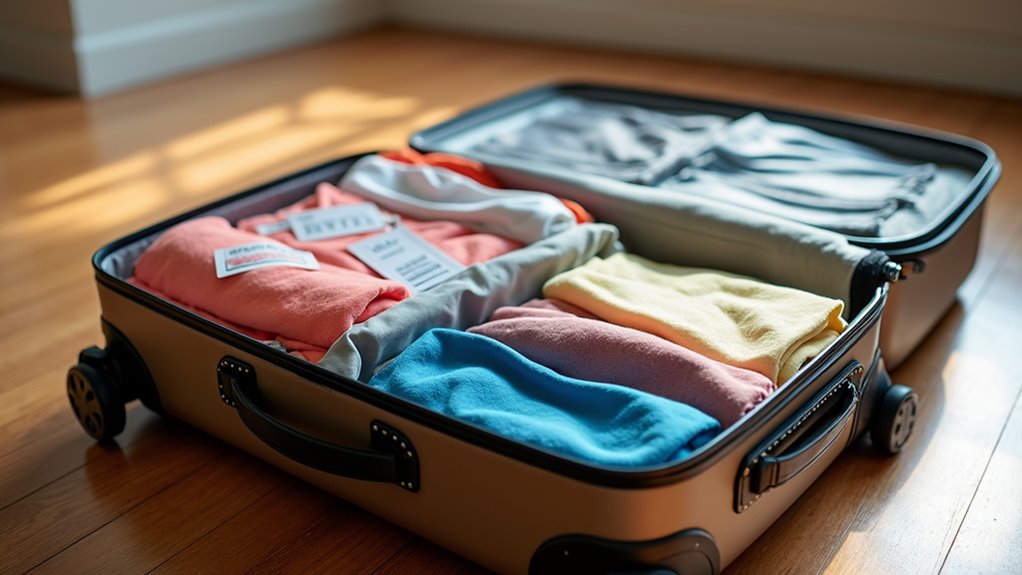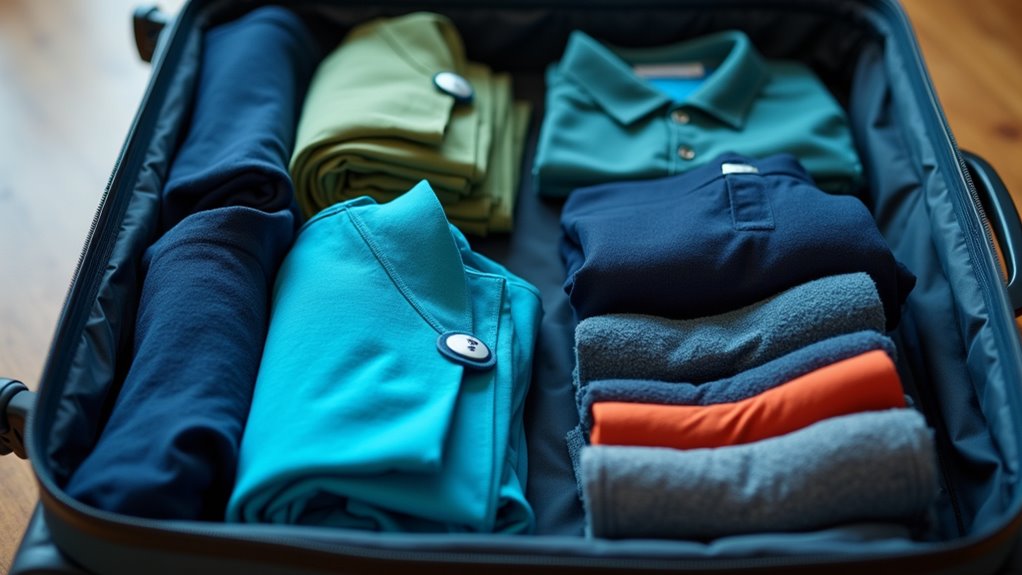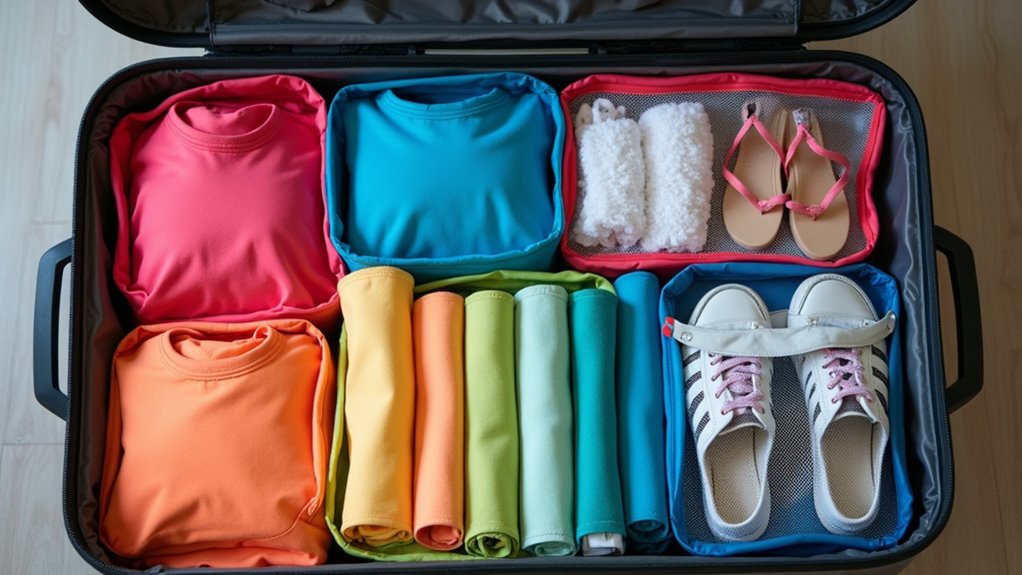Physical Address
304 North Cardinal St.
Dorchester Center, MA 02124
Physical Address
304 North Cardinal St.
Dorchester Center, MA 02124

Outsmart common packing pitfalls that ruin camp experiences with these five game-changing strategies every parent wishes they knew beforehand.
Like a chess master planning moves ahead, you’ve got to think strategically when packing for summer camp—one forgotten essential can derail your entire experience. You’ll face soggy clothes after unexpected downpours, misplaced gear when you need it most, and overstuffed bags that become daily wrestling matches. The difference between campers who thrive and those who struggle often comes down to five key packing principles that transform chaos into confidence, ensuring you’re prepared for whatever adventure comes next.

When you’re sending your child off to summer camp, the right luggage makes all the difference between organized packing and chaotic scrambling. Skip wheeled suitcases—they’re impractical for bunk beds and dirt paths. Instead, choose a large duffel bag or backpack that your child can easily carry and store.
Create a foolproof labeling system using permanent markers and waterproof labels. Write your child’s name, cabin number, and your phone number on everything—inside and outside each bag. Consider bright duct tape or colorful ribbon tied to zippers for quick identification during luggage sorting.
Pack a smaller daypack for daily activities and trips. Your child will thank you when they can quickly grab essentials without digging through their main bag.
If your family enjoys RV adventures, consider attending Britain’s Motorhome Show to explore specialized travel gear that could enhance your camping experiences year-round.
What separates a prepared camper from one who’s constantly borrowing supplies? A solid checklist of camp essentials.
Pack enough underwear and socks for each day, plus extras. You’ll need quick-dry clothing, sturdy shoes, and flip-flops for showers. Don’t forget a wide-brimmed hat and quality sunscreen.
Pack smart with daily essentials plus backup underwear and socks, quick-dry fabrics, reliable footwear, and sun protection gear.
Your toiletry kit should include toothbrush, toothpaste, shampoo, soap, and deodorant. Add any prescription medications in original containers. Include a flashlight with extra batteries and a reusable water bottle.
Bring insect repellent, basic first-aid supplies, and a laundry bag for dirty clothes. Pack a small towel that dries quickly and comfortable sleepwear.
Most camps provide bedding, but check first.
Your phone charger and a small amount of spending money round out your essentials.
When selecting outdoor equipment, prioritize kids camping gear that’s appropriately sized and durable enough to withstand active use.

Although bringing clothes for several weeks might seem intimidating, you don’t need to pack your entire wardrobe. Focus on versatile pieces that mix, match, and layer easily. Choose quick-dry fabrics that’ll handle daily activities and frequent washing.
Pack strategically with these core principles:
Stick to a simple color palette so everything coordinates. Skip fancy outfits and focus on comfortable, durable clothing that can withstand camp adventures and frequent washing cycles. These family camping principles apply equally well to youth camps, where practical clothing choices ensure campers stay comfortable throughout their adventure.
Since weather can make or break your camp experience, you’ll want to prepare for every condition Mother Nature might throw your way. Pack a quality rain jacket and waterproof poncho – you’ll need both for different activities. Include quick-dry pants and shorts that won’t leave you soggy all day. Don’t forget a warm fleece or hoodie for chilly evenings, even during summer months.
Check the specific forecast before departure, but always pack one extra layer beyond what you think you’ll need.
Waterproof bags protect electronics and important documents from unexpected downpours. Pack extra socks and underwear in sealed bags – wet feet lead to blisters and misery. A compact umbrella works great for light rain during outdoor activities. Learning from common backpacking mistakes can help you avoid the weather-related mishaps that often ruin camping trips.

When you’re living out of a suitcase or duffel bag for weeks, smart organization becomes your best friend for stress-free mornings and quick outfit changes. You’ll save precious time and avoid frantic searching when everything has its designated spot.
Here are three game-changing organization strategies:
Transform your travel chaos into organized bliss with these proven packing methods that seasoned travelers swear by.
These same packing principles apply whether you’re heading to camp by car or planning water activities where you might consider whether to rent or buy a boat for the group’s fishing excursions.
You’ve got all the tools to pack like a pro for summer camp. Remember, less is more—stick to versatile basics, weatherproof essentials, and smart organization systems. Label everything, roll don’t fold, and keep that daypack handy. Don’t reinvent the wheel; follow the one-week rule and you’ll stay comfortable without lugging around unnecessary baggage. With these strategies, you’ll spend less time digging through your stuff and more time making memories.